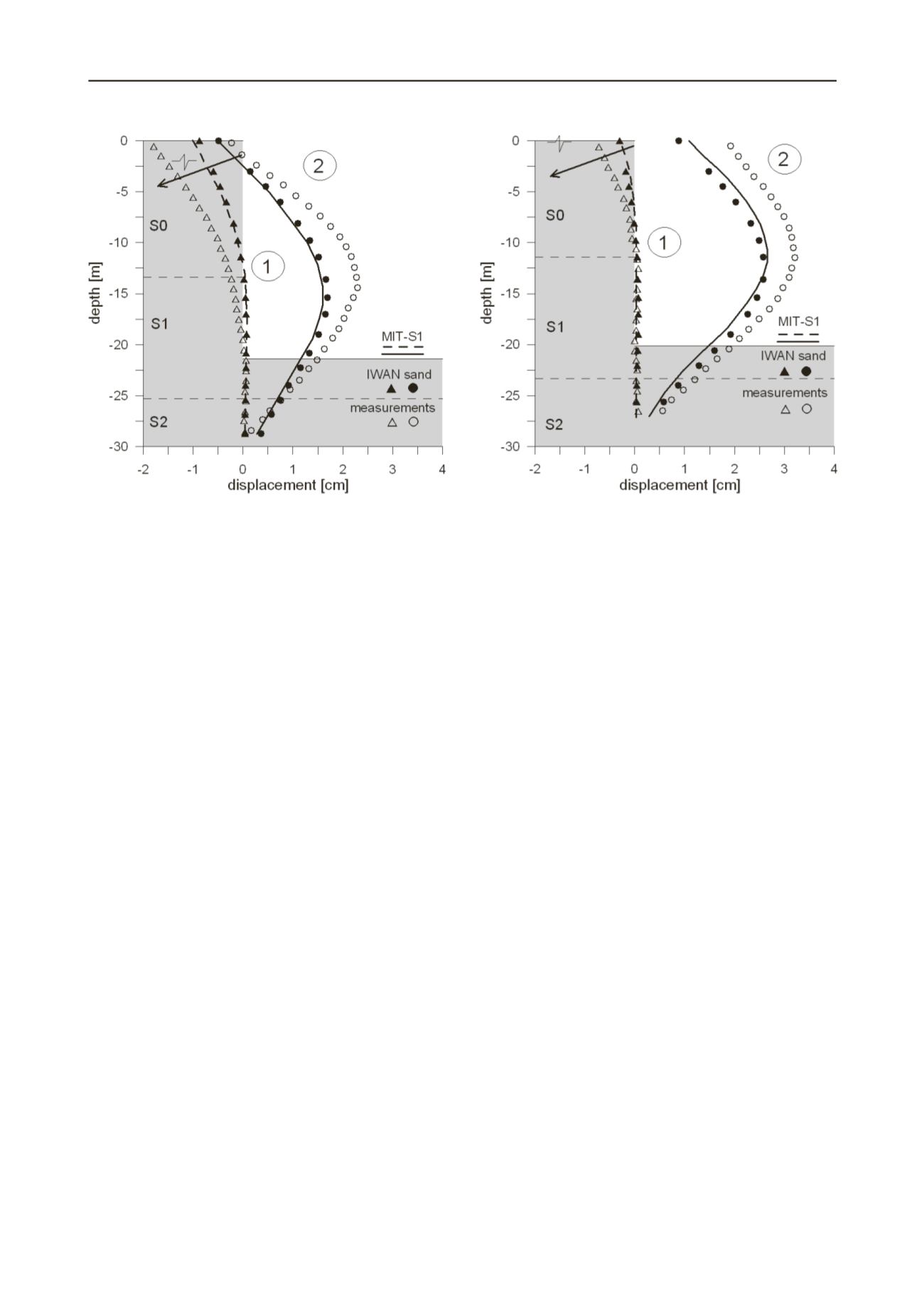
812
Proceedings of the 18
th
International Conference on Soil Mechanics and Geotechnical Engineering, Paris 2013
Figure 4. Comparison of measured and predicted displacement of
diaphragm wall at MQ3 profile (excavation depth = 21.4 m; wall
thickness = 1.5 m, height = 28.78 m; anchor free length = 34.5 m, fixed
length = 8.0 m, dip angle = 35
o
, prestress = 540 kN, spacing = 1.0 m);
(1) – prestressing of geotechnical anchor; (2) – final excavation.
Figure 5. Comparison of measured and predicted displacement of
diaphragm wall at MQ5 profile (excavation depth = 20.1 m; wall
thickness = 1.2 m, height = 27.20 m; anchor free length = 26.5 m, fixed
length = 8.0 m, dip angle = 25
o
, prestress = 292 kN, spacing = 1.2 m);;
(1) – prestressing of geotechnical anchor; (2) – final excavation
The retaining structure is modeled by using plate elements for
diaphragm wall and using anchor / geotextile elements for
geotechnical anchors. The analysis is performed in three
characteristic phases: (0) – excavation to the anchor installation
level; (1) – installation and pre stressing of the anchor;
(2) – excavation to the final depth. Detailed information about
structure elements, geometry of the excavation pit and material
properties can be found in Nikolinakou (2011).
6
REFERENCES
Brinkgrawe R.B., Broere W. and Waterman D. 2008. PLAXIS 2D
Version 9, Plaxis bv. Delft
Collins I.F., Muhunthan B., Tai A.T. and Pender M.J. 2007. The
concept of a 'Reynolds-Taylor state' and the mechanics of sands.
Géotechnique
57 (5), 437-447.
Fahey M. and Carter J.P. 1993. A finite element study of the
pressuremeter test in sand using a nonlinear elastic plastic model.
Canadian Geotechnical Journal
30, 348-361.
Gutierrez M. 2003. Modeling of steady-state response of granular soils.
Soils and Foundations
43 (5), 93-105.
5
DISCUSSION AND CONCLUSION
A numerical simulation of isotropic compression of Berlin sand
(Figure 2.a) shows the capability of the IWAN model to predict
the volumetric strain development following the concept of
limit compression line. IWAN model accurately predicts
measured sand behavior, and overall behave similarly to the
MIT-S1 soil model.
Iwan W. D. 1967. On a class of models for the yielding behavior of
continuous and composite systems.
Journal of Applied Mechanics,
34 (3), 612-617.
Jefferies M. and Been K. (2006). Soil liquefaction - A critical state
approach
.
Oxon: Taylor & Francis.
Li X.S. and Dafalias Y.F. 2000. Dilatancy for cohesionless soils.
Géotechnique
50 (4), 449-460
Numerical simulation of drained triaxial tests (Figure 3.a)
shows the capability of the IWAN model to predict the real sand
behavior of dense and loose samples. Comparing the results to
the results gained by MIT-S1 soil model, the prediction of peak
strength, stress reduction and dilatancy is more accurate.
Masing G. 1926. Eigenspannungen und Vervestigung beim Messing.
Proceedings, Second International Congress of Applied Mechnaics
(pp. 332-335). Zürich: Orell Füssliverlag.
Muir Wood D. 1990. Soil Behavior and Critical State Soil Mechanics.
Cambridge, UK: Cambridge University Press
Prediction of displacements for the deep excavation using
IWAN model (Figure 4 and 5) are similar to predictions using
MIT-S1 model. Minor deviation of results can be observed for
the final excavation depth on MQ5 profile while all other
simulations give almost same results. Comparing predictions to
inclinometer measurements of wall displacements, the same
trend can be observed. For the case of anchor prestressing wall
displacements are toward the back soil, and attain typical shape
of inward movement for the final excavation.
Nikolinakou M.A., Whittle A.J., Savidis S. and Schran U. 2011.
Prediction and Interpretation of the Performance of a Deep
Excavation in Berlin Sand,
Journal of geotechnical and
Geoenvironmental Engineering
, ASCE, Nov.2011.
Pestana J.M. and Salvati L.A. 2006. Small-Strain Behavior of Granular
Soils. I: Model for Cemented and Uncemented Sands and Gravels.
Journal of Geotechnical and Geoenvironmental Engineering
132
(8), 1071-1081.
Segelman D.J. and Star M.J. 2008. Inversion of Masing models via
continuous Iwan systems.
International Journal of Non-Linear
Mechanics
, 43, 74-80.
Observed results add to the confidence of using IWAN soil
model in complex numerical simulation. The model predicts
well real sand behavior for wide range of stress, strain and
densities by using a single set of input parameters. Material
parameters for the shear and dilatancy, calibrated to several
sand types, may be used with confidence, while the basic
parameters can be derived from basic laboratory and in situ
tests.
Sheng D., Yao Y. and Carter J. P. 2008. A volume-stress model for
sands under isotropic and critical states.
Canadian Geotechnical
Journa,
45, 1639-1645.
Sokolić I. 2010. A sand model embedded into the generalized Iwan
system, unpublished PhD Thesis, Faculty of Civil Engineering
Zagreb (in Croatian, unpublished)


